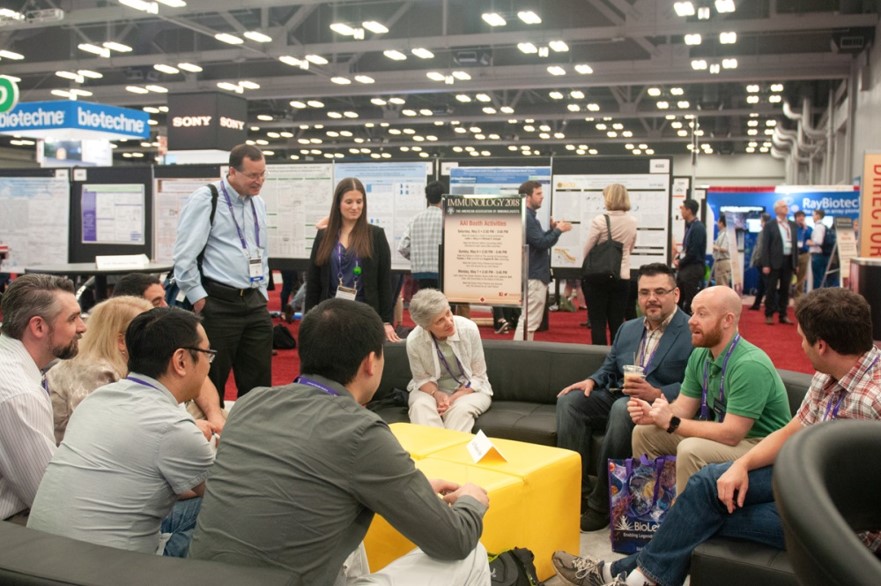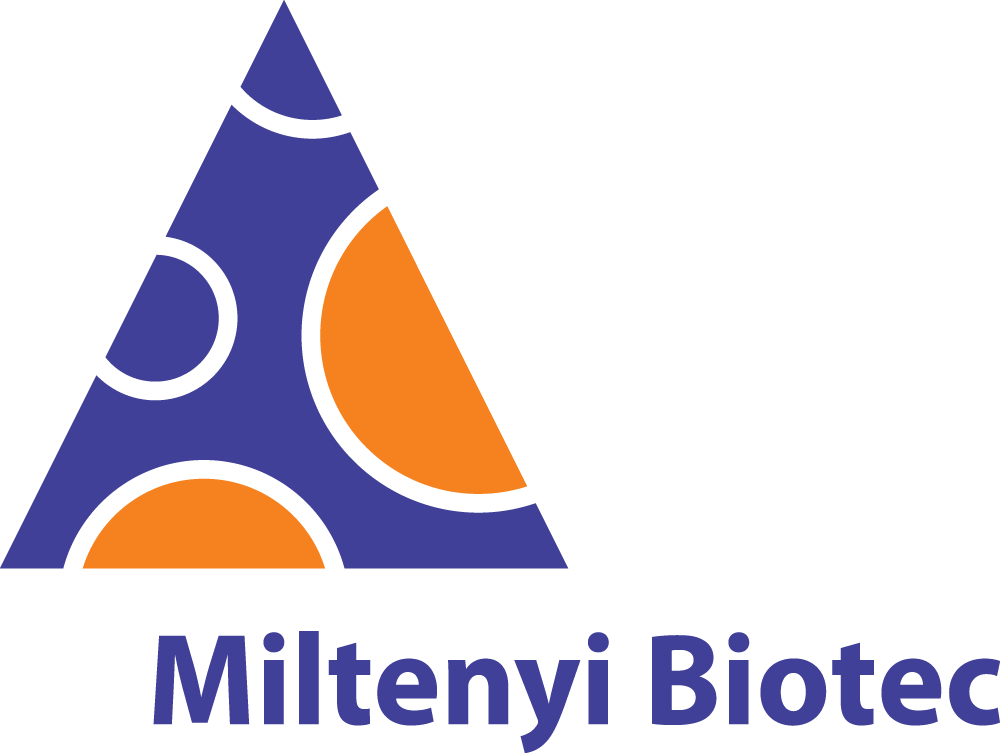All listings subject to change.
Tuesday, May 11, 2021 8:00 AM – 8:30 AM ET
Morning Yoga

Generously supported by Thermo Fisher Scientific
Join us every morning for a 30-minute yoga-and-mindfulness session. We experience distractions and stressors that pull our attention in many directions. This class will relax you and prepare you to be fully present before engaging in your selected sessions during the day ahead.
Tuesday, May 11, 2021 9:00 AM – 10:30 AM ET
Poster Sessions
Regulation of T Cells, B Cells, and Antibodies in Autoimmunity
Cytokine and Chemokine Activity during Cancer and Chronic Inflammation
It’s All in the Cells: T Cells, Mast Cells, Basophils, and ILCs
Mobilizing Immune Responses
Molecular Mechanisms of T Cell Signaling
Technological Innovation I (Tech Innovation and Interesting Results)
Technological Innovation II (Interesting Tech Development)
Transplantation Immunology
Vaccines and Immunotherapy against SARS-CoV-2
Immunomodulators; Checkpoint Inhibitors, Cytokines, Adjuvants, and Agonists
Tuesday, May 11, 2021 10:30 AM – 11:30 AM ET
Exhibitor Workshops
Tuesday, May 11, 2021 10:30 AM – 12:30 PM ET
American Society of Tropical Medicine and Hygiene (ASTMH) Symposium
Immune Lessons from Parasites
Chairs:
- Keke Fairfax, Univ. of Utah
- Christine Petersen, Univ. of Iowa
Speakers:
- Elia D. Tait Wojno, Univ. of Washington, Prostaglandin regulation of intestinal epithelial responses to helminths
- Jude E. Uzonna, Univ. of Manitoba, Canada, Regulation of immunity to cutaneous leishmaniasis by the long pentraxin-3
- Camila H. Coelho*, NIAID, NIH, Antibody repertoire analyses in response to malaria vaccines at the single B cell level
- Pedro H. Gazzinelli-Guimaraes*, NIAID, NIH, Allergen-driven CD30L+ Th2 effector cells promote an IL-5/IL-13 mediated eosinophil-dependent protective immunity against helminth larval stages in the lungs
- Keke Fairfax, Univ. of Utah, Unwinding helminth antigen-driven reprogramming of host immunity
* Top trainee presentation from ASTMH
Tuesday, May 11, 2021 10:30 AM – 12:30 PM ET
International Society of Developmental and Comparative Immunology (ISDCI) Symposium
Diversity and Conservation of Immune Mechanisms in Deuterostomes
Chairs:
- Michael F. Criscitiello, Texas A&M Univ.
- Yuko Ota, Univ. of Maryland Sch. of Med.
Speakers:
- Katherine M. Buckley, Auburn Univ., System-wide responses to infection in sea urchin larvae reveal fundamental aspects of animal immunity
- Benyamin Rosental, Ben Gurion Univ. of the Negev, Israel, Evolutionary perspective on the hematopoietic and immune systems through allogeneic immunity of a colonial chordate
- Yuko Ota, Univ. of Maryland Sch. of Med., Evolution of the vertebrate NKp30 family
- Leon Grayfer, George Washington Univ., Determinants of amphibian immune susceptibility and resistance against the deadly chytrid fungus
Tuesday, May 11, 2021 10:30 AM – 12:30 PM ET
Society for Mucosal Immunology (SMI) Symposium
Mechanisms of Inter-Tissue Communication
Chairs:
- Ivaylo I. Ivanov, Columbia Univ.
- Lauren A. Zenewicz, Univ. of Oklahoma Hlth. Sci. Ctr.
Speakers:
- Daria Esterházy, Univ. of Chicago, Immune homeostasis through compartmentalized gut lymph node drainage
- Soman N. Abraham, Duke Univ., Transmission of blood borne allergens by CD301b+ dendritic cells to perivascular mast cells
- Iliyan D. Iliev, Weill Cornell Med., Gut mycobiota tunes host systemic immunity and gut-distal tissue immune environment
- Lora V. Hooper, Univ. Texas Southwestern Med. Ctr., Bacterial regulation of vitamin A transport in the intestine
Tuesday, May 11, 2021 10:30 AM – 12:30 PM ET
Block Symposia
Tissue Resident Immune Cells
Generously supported by BioLegend
Adapting Immunology Education to the Present Needs: COVID-19 and Beyond
Generously supported by Sony Biotechnology
Engineered T Cells for Cancer Immunotherapy
Generously supported by NanoString Technologies
Tuesday, May 11, 2021 11:00 AM – 12:00 PM ET
AAI Vanguard Lecture
Sponsored by the AAI Minority Affairs Committee
Chairs:
- Tonya J. Webb, Univ. of Maryland Sch. of Med., AAI Minority Affairs Committee Chair
- Robert J. Binder, Univ. of Pittsburgh
Speaker:

De’Broski R. Herbert
Univ. of Pennsylvania Sch. of Vet. Med.
IL-33 regulates the balance between inflammation and immunosuppression
Presented by an AAI member selected by the Minority Affairs Committee for their scientific achievement and exemplary career success
Tuesday, May 11, 2021 12:30 PM – 1:30 PM ET
Distinguished Lecture—Michael P. Cancro
Generously supported by Sony Biotechnology
Chairs:
- David Masopust, Univ. of Minnesota, AAI Program Committee Chair
- Jeffrey C. Rathmell, Vanderbilt Univ. Med. Ctr.
Speaker:

Michael P. Cancro
Perelman Sch. of Med., Univ. of Pennsylvania
A tale of two subsets: rethinking B cell selection, homeostasis, and memory
Tuesday, May 11, 2021 2:00 PM – 3:00 PM ET
Exhibitor Workshop
Tuesday, May 11, 2021 2:00 PM – 5:30 PM ET
Major Symposium C
Immunological Angle on the Brain and its Diseases
Generously supported by Adaptive Biotechnologies
Chairs:
- Jonathan Kipnis, Washington Univ. Sch. of Med.
- Zsuzsanna Fabry, Univ. of Wisconsin Sch. of Med.
Speakers:
- Zsuzsanna Fabry, Univ. of Wisconsin Sch. of Med., Dendritic cells link neuroinflammation and lymphangiogenesis in the brain
- Antoine Louveau, Lerner Res. Inst., Cleveland Clin., Regulation of brain maturation by the meningeal lymphatic vasculature
- Isaac M. Chiu, Harvard Univ., Role of neuro-immune interactions in bacterial host defense
- Ashley E. Moseman, Duke Univ. Sch. of Med., Coordinating CNS host defense following olfactory neuroinvasion
- Stanley Perlman, Univ. of Iowa, Coronavirus infections of the CNS and immunological responses
- Beth Stevens, Boston Children’s Hosp., Harvard Med. Sch., Mapping microglia states to function in health and disease
Tuesday, May 11, 2021 2:00 PM – 5:30 PM ET
Major Symposium D
Innate Immunity—The Good, The Bad, The Ugly
Generously supported by Sony Biotechnology
Chairs:
- Clara Abraham, Yale Univ.
- Katherine A. Fitzgerald, Univ. of Massachusetts Med. Sch.
Speakers:
- Clara Abraham, Yale Univ., Modulation of innate immune responses by disease-associated genes
- Katherine A. Fitzgerald, Univ. of Massachusetts Med. Sch., Regulation of inflammation by nucleic acid-binding proteins
- Daniel B. Stetson, Univ. of Washington, Innate immune detection of intracellular DNA
- Raphaela T. Goldbach-Mansky, NIAID, NIH, Innate immune dysregulation in autoinflammatory diseases
- Gregory F. Sonnenberg, Weill Cornell Med., Immune regulation of intestinal health
- Kodi S. Ravichandran, Univ. of Virginia, Soothing messages on the way out: apoptotic cell communication with the neighborhood
Tuesday, May 11, 2021 2:00 PM – 4:00 PM ET
The U.S. COVID-19 Response: Successes, Failures, and Ongoing Challenges
Sponsored by the AAI Committee on Public Affairs
Chairs:
- Ross M. Kedl, Univ. of Colorado Anschutz Sch. of Med., AAI Committee on Public Affairs Chair
- Kristin A. Hogquist, Univ. of Minnesota Ctr. for Immunology
Speakers:
- A. Nicole Clowers, M.P.A., U.S. Government Accountability Office, Evaluating the federal government’s response to the COVID-19 pandemic
- Leandris Liburd, Ph.D., M.P.H., M.A., Office of Minority Health and Health Equity, CDC, Advancing health equity: Addressing COVID-19 health disparities
- Katherine Wu, Ph.D., The Atlantic, The importance of understanding human behavior in combatting the COVID-19 pandemic
The COVID-19 pandemic is the greatest public health crisis that the United States has faced in the last 100 years. In some ways, the U.S. rose to the challenge, with several vaccines against COVID-19 developed and approved (under Emergency Use Authorizations by the Food and Drug Administration) in record-shattering speed, and with more vaccine candidates showing promise. But undeniable shortcomings hampered the response, from an insufficient supply of personal protective equipment to inadequate testing and contact tracing, to confusing – or incorrect – communications from federal agencies and officials. This session will dive deeper into some of the strengths and weaknesses, past and present, of the U.S. response and explore the challenges that lie ahead for combating the current pandemic and for better positioning our nation to prevent – or respond to – the next one. AAI will welcome a distinguished panel of experts to discuss these crucial topics and answer audience questions.
Tuesday, May 11, 2021 2:00 PM – 4:00 PM ET
NIH Grants Workshop: Demystifying the Grant Application Submission, Review, and Funding Processes
Chair:
- Tina M. McIntyre, CSR, NIH
Panelists:
- Tina M. McIntyre, CSR, NIH
- Joseph Breen, NIAID, NIH
- Deborah L. Hodge, CSR, NIH
This workshop will provide participants with an overview of NIH grant submission, assignment, review, and funding opportunities. Emphasis will be given to identification of the most appropriate funding agencies and mechanisms available through NIH, how to make an application “reviewer friendly,” and other strategies that contribute to applications that succeed in obtaining research funding. The workshop will also provide information on how to understand the peer review system, which is essential to competing successfully for funding, with a focus on recent changes to the review process. NIH review and program staff will provide a broad array of expertise and encourage questions from seminar participants. This workshop is open to anyone interested in learning more about preparing an NIH grant application and obtaining NIH funding. Trainees and independent investigators are welcome.
Tuesday, May 11, 2021 2:00 PM – 4:00 PM ET
Block Symposia
CD4+ T Cell Regulation and Responses
Generously supported by Sony Biotechnology
Tumor Microenvironment and Anti-tumor Immunity
Generously supported by Miltenyi Biotec
Molecular and Transcriptional Regulation of Autoimmunity
Generously supported by Bio X Cell
Tuesday, May 11, 2021 3:00 PM – 4:00 PM ET
Exhibitor Workshop
Tuesday, May 11, 2021 4:00 PM – 5:00 PM ET
Exhibitor Workshop
Tuesday, May 11, 2021 5:00 PM – 7:00 PM ET
Careers in Science Roundtables
Sponsored by the AAI Education Committee & AAI Committee on the Status of Women
Generously supported by the Allen Institute for Immunology
Chairs:
- Laura A. Solt, Scripps Res., AAI Committee on the Status of Women Chair
- Dorina Avram, H. Lee Moffitt Cancer Ctr. and Res. Inst.
Speaker:
- Joan M. Goverman, Univ. of Washington, Overcoming self-doubt and becoming a confident scientist
At this popular session, attendees will have the opportunity to meet with experienced scientists to explore specific career issues important to today's scientists. Gain insights into issues you are confronting in your own career. Topics include international opportunities in science, succeeding in graduate school, tips on grant writing, considerations for scientists in M.D.-Ph.D. careers, and exciting careers beyond the bench. New to the 2021 session are topics on building productive mentor/mentee relationships, overcoming self-doubt, and tackling gender biases in recruitment, research, and leadership. Other topics will include navigating work-life issues, such as balancing careers with family and transitioning from specific career stages, which may be relevant to any work environment (academic research, biotech industry, governmental agencies, non-profit). Don’t miss this great opportunity!
Discussion topics
New PI (mentoring effectively, recruiting students and postdocs, preparing for promotion, tips for balancing teaching and research)
- Shari Pilon-Thomas, Moffitt Cancer Ctr.; Irene Salinas, Univ. of New Mexico
- Keke Fairfax, Univ. of Utah; Melissa Brown, Northwestern Univ. Feinberg Sch. of Med.
Succeeding in Graduate School
- Laura Solt, Scripps Reseacrh Institute; Katherine Buckley, Auburn University
Graduate Student to Postdoc
- Natalie Steinel, Univ. of Massachusetts, Lowell; Ann Griffith, Univ. of Texas Hlth., San Antonio
- Evelien Bunnik, Univ. of Texas Hlth., San Antonio; Lisa Denzin, Rutgers Robert Wood Johnson Med. Sch.
Postdoc to PI
- Paulo Rodriguez, Moffitt Cancer Ctr.; Juliet Morrison, Univ. of California, Riverside
- Guangming Zhong, Univ. of Texas Hlth., San Antonio; Justin Milner, Univ. of Northa Carolina at Chapel Hill
Work/Life Balance
- Kate MacNamara, Albany Med. Col.; Daniela Gomez-Atria, Univ. of Pennsylvania
Building Networking Skills
- Meera Nair, Univ. of California, Riverside; Yina Huang, Geisel Sch. of Med. at Dartmouth
Biotech and Industry
- Theodore Drashanky, Merck; Sadiye Rieder, Horizon Therapeutics
- Divya Sagar, Loxo Onc at Lilly; Annie Lau-Kilby, Horizon Therapeutics
- Frann Antignano, StemCell Technologies; Kerry Casey, Regeneron
- Lisa Caproni, Touchlight Genetics; Tamara Reyes Robles, Merck Research Laboratories
- Isis Kanevsky, Pfizer; Ingrid Scully, Pfizer
- Louis Gonzalez, Shattuck Labs; Laura Walker, Adimab; Lynn Becker, The Allen Inst.
Overcoming Self-Doubt and Becoming a Confident Scientist
- Sarah Gaffen, Univ. of Pittsburg; Joan Goverman, Univ. of Washington
Tackling Gender Biases in Recruitment, Research, and Leadership
- Dorina Avram, Moffitt Cancer Ctr.; Ilhem Messaoudi, Univ. of California, Irvine
Careers in Government Agencies
- Deborah Hodge, NIH/CSR; Swinburne (Jason) Augustine, EPA
Scientific Publishing
- Liang Zhou, Univ. of Florida; Catarina Sacristan, Trends in Immunology
Opportunities for Scientists in Non-profits/Foundations & Careers in Science Policy
- Aliyah Weinstein, Addgene; Troy Torgerson, The Allen Inst.
Grant Writing for PIs
- Jose Conejo-Garcia, Moffitt Cancer Ctr.; Melissa Lodoen, Univ. of California, Irvine
Research from M.D., Ph.D. Perspective/The Physician Scientist
- Tyler Curiel, Univ. of Texas Hlth., San Antonio; Megan Cooper, Washington Univ., St. Louis
International Opportunities
- JoAnne Flynn, Univ. of Pittsburgh; Lubka Roumenina, Cordeliers Res. Ctr.
- Judith Mandl, McGill Univ.; Carlos Acevedo-Suarez, Univ. of Puerto Rico
Tuesday, May 11, 2021 5:00 PM – 7:00 PM ET
Block Symposia
Mechanisms of Viral Sensing and Innate Immune Responses
Tregs and Tolerance in Autoimmunity
Generously supported by Thermo Fisher Scientific
Autoimmunity and Primary Immune Deficiency
Generously supported by BD Biosciences
Understanding and Modulating Lymphocytes in Tumor Immunology
Generously supported by STEMCELL Technologies, Inc.
Novel Strategies for the Vaccination and Immunotherapy against Infectious Diseases
Generously supported by Bio-Rad Laboratories
Tuesday, May 11, 2021 6:00 PM – 7:00 PM ET
Exhibitor Workshop
Tuesday, May 11, 2021 6:00 PM – 8:00 PM ET
Meet the Editor-in-Chief

Meet the Editor-in-Chief of ImmunoHorizons,
Mark H. Kaplan, at the AAI Journals Booth
Tuesday, May 11, 2021 7:00 PM – 8:00 PM ET
Meet the AAI Public Policy Fellows

Meet the AAI Public Policy Fellows and discover why YOU should be our next Fellow!
Join us in the AAI booth.
Tuesday, May 11, 2021 8:00 PM – 9:00 PM ET
The Wine Report

Generously supported by STEMCELL Technologies, Inc.
Discover the unique aromatic and taste profiles of featured wines while also safely socializing in a virtual environment. Led by a certified sommelier who can answer your most pressing wine-related questions!
(Please drink responsibly.)






